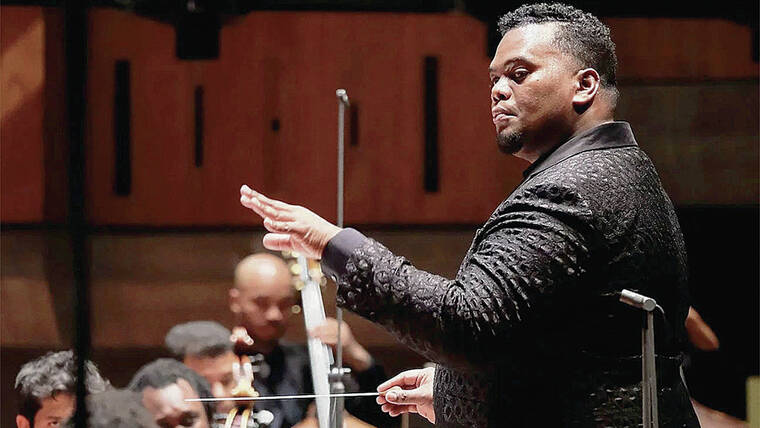Mahalo for supporting Honolulu Star-Advertiser. Enjoy this free story!
February will be a treat for classical music fans, who can look forward to symphony, opera and chamber music concerts featuring acclaimed performers, and up-and-coming talent playing some underappreciated composers and compositions. Even dog lovers will find something appealing.
Symphony
The Hawai‘i Symphony Orchestra opens the month with a Masterworks Series concert honoring African American History Month on Feb. 5. The program features Florence Price’s “Symphony No. 3” and Samuel Coleridge-Taylor’s “Ballade.”
Also on the program is Alexander Glazunov’s challenging violin concerto. Karen Gomyo, a Japanese-born violinist who studied at The Juilliard School in New York and has received acclaim for her interpretation of tango music, will solo in the Glazunov (1865-1936) piece. Maestro Anthony Parnther, who works frequently in film and television scoring with the Hollywood Studio Symphony and has led several regional orchestras in Southern California, will conduct the orchestra.
“Glazunov was a composer who felt like Russian composers should really write Russian music,” drawing on Russian folklore, said Michael-Thomas Foumai, HSO’s composer-in-residence. “It’s melody upon melody, never-ending melody that the violin plays over 20 minutes or so.”
Price (1887-1853), whose work has enjoyed a renaissance among audiences in recent years, was the first Black female composer whose work was performed by a major American symphony, the Chicago Symphony. Her work usually featured references to African American spirituals and gospel, but her third symphony includes “glimpses of French music like Debussy, and even operatic music like Wagner,” said Foumai. “It has a ‘Golden Age of Hollywood’ sound.”
Coleridge-Taylor (1875-1912), a British composer of African descent, wrote music that “almost sounds like Rachmaninoff,” Foumai said. “He’s known as the African ‘Mahler.’ His music is very operatic.”
The concert featuring the Black composers and Glazunov is at 4 p.m.
Foumai’s work as an orchestrator can be heard in a HapaSymphony Series concert at 7:30 p.m. Saturday, which will feature the music of Keauhou.
Both concerts will be held at Hawaii Theatre Center. Tickets are $18 to $99, available at hawaiitheatre.com or myhso.org.
Opera
Hawaii Opera Theatre’s new production, “The Elixir of Love,” offers welcome contrast to the old trope of opera ending in tragedy, with the soprano singing an overwrought aria as she takes her last breath. Instead, composer Gaetano Donizetti’s masterpiece is “totally rom-com,” said Andrew Morgan, HOT general director.
This production will have a local twist, with the story set on a Hawaiian plantation where the shy farm worker Nemorino (Andrew Stenson) has feelings for the owner Adina (Natalie Image). He finds the courage to pursue her with the help of a “magic” love potion, which turns out to be nothing more than rum (in the original, it’s wine). Costuming will consist of aloha attire picked up at flea markets and thrift shops, while set designer Michelle Bisbee used the Hawaii’s Plantation Village as inspiration for her set.
“It’s our first completely home-built set in 25 years,” Morgan said.
Morgan said Image has a “sparkling voice, and an equally sparking stage presence,” and that Stenson will be singing a “perfect piece for him” in the second-act aria “A furtive tear,” which is considered one of the most romantic works in the opera repertoire. Efrain Solis will portray the traveling salesman Dulcamara, who sells Nemorino the love potion, and quack that he is, he gets to sing a lot of entertaining “patter” songs, with quick, witty lyrics. “He is just dynamite at that,” Morgan said. The opera will be sung in English, part of Morgan’s effort to make opera accessible to audiences.
The opera will be staged at 7:30 p.m. Feb. 17 and 4 p.m. Feb. 19 at Blaisdell Concert Hall. Tickets are $30 to $135, available at hawaiiopera.org or 808-596-7858.
Chamber music
Hawaii was privileged to hear Yo-Yo Ma a few weeks ago, and now the Honolulu Chamber Music Series hosts another brilliant cellist, Steven Isserlis, performing with pianist Connie Shih. Isserlis has been at the forefront of the cello performance for decades, and is also a music podcaster and author of children’s books. He’s known for performing on gut strings, which create a distinctly warm sound, on his rare Stradivarius cello. His program of Bach, Brahms, Chopin and his transcription of Schumann should show the far reaches of his artistry, combined with his historically informed performance style. The recital is at 7:30 p.m. Feb. 18 at Orvis Auditorium at the University of Hawaii at Manoa. Tickets are $15 to $45, available at honoluluchamber musicseries.org.
February closes out with Chamber Music Hawai‘i presenting the Honolulu Brass Quintet performing Leonard Bernstein’s “Suite for Brass,” a work written in memory of dogs that belonged to friends of Bernstein, a dog lover. One movement, “Rondo for Lifey,” was dedicated to actor Judy Holliday’s Skye terrier, while “Fanfare for Bima” is based on the theme that fellow maestro Serge Koussevitzky would whistle to call his cocker spaniel. Performances are at 7 p.m. Feb. 25 at Doris Duke Theatre, 4 p.m. Feb. 26 at Paliku Theatre at Windward Community College and 7 p.m. Feb. 27 at UH-West Oahu library. Tickets are $35, available at chambermusichawaii.org.
